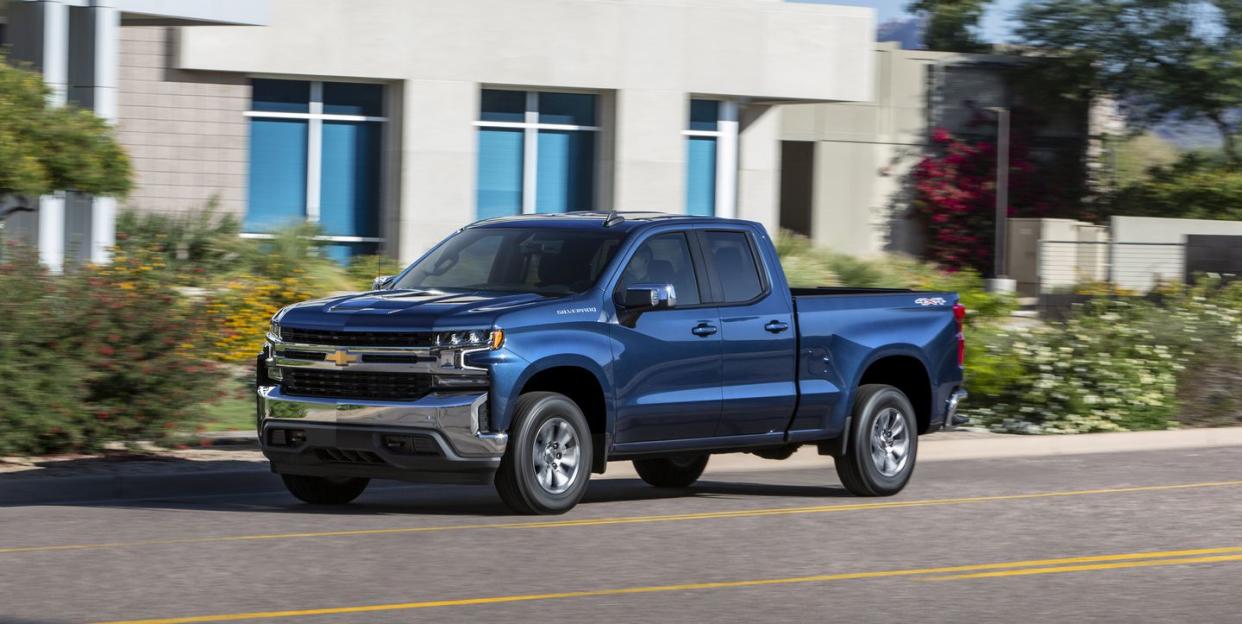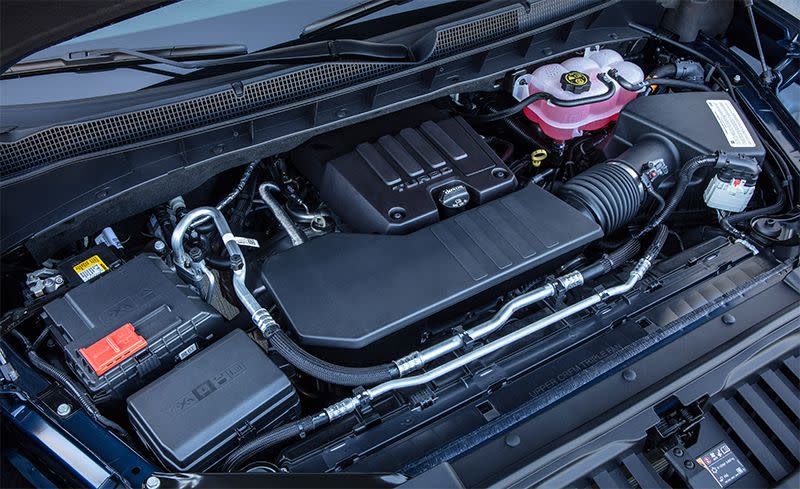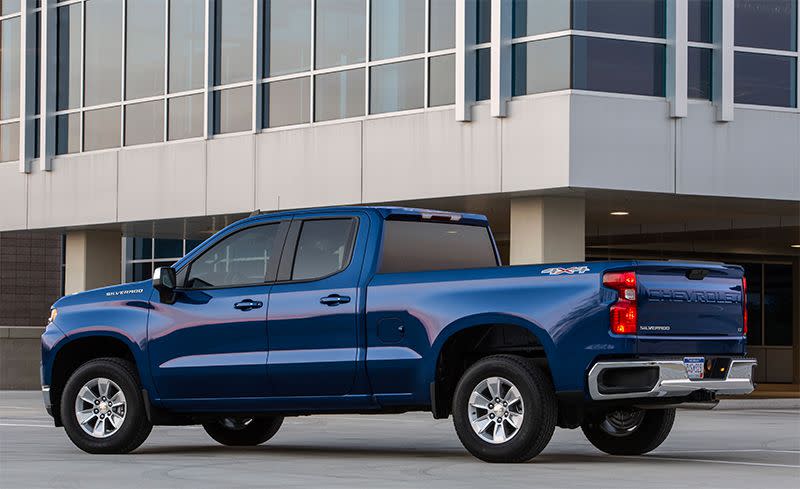2019 Chevrolet Silverado 1500 2.7T Four-Cylinder Pair Together Surprisingly Well

Of the many highlights found in the new-for-2019 Chevrolet Silverado 1500, from the bold new styling to its cleverly optimized cargo box to a factory-lifted off-road variant, the addition of an available four-cylinder engine-a first for a modern full-size pickup-is certainly the most controversial. Beyond incurring the stigma of a wheezy four-banger in a big, burly pickup, can just four cylinders effectively motivate that much tonnage? The simple answer is yes, impressively so, even if the combination will take some getting used to.
The engine in question is General Motors' new turbocharged DOHC 2.7-liter inline-four, dubbed L3B, which comes as the standard powertrain on mid-level Silverado LT and RST models, as well as on SLE and Elevation versions of the equally new 2019 GMC Sierra 1500. Designed from the ground up as a truck engine, the long-stroke 2.7T is big for a four-pot studded with technology: direct fuel injection, cylinder deactivation, a BorgWarner twin-scroll turbocharger with separate inlet chambers, and variable intake- and exhaust-valve timing and lift.
Doing the Twist
The boosted 2.7 produces a solid 310 horsepower at 5600 rpm, but it's the beefy 348 lb-ft of torque stretching from 1500 to 4000 revs that really matters-that's 43 lb-ft more, at far lower rpm, than is available from the base 285-hp 4.3-liter V-6 found in lesser Silverados, and only 35 lb-ft less than the 355-hp 5.3-liter small-block V-8 (a $1395 option on both the LT and RST.) It mates solely to an eight-speed automatic transmission, and GM says the setup allows 2.7T-equipped Silverados to tow up to 7200 pounds and scoot to 60 mph in less than 7.0 seconds.
A proper track test will have to confirm that pace, yet it feels entirely reasonable from our initial drive in and around Phoenix, Arizona, in roughly 5000-pound double-cab four-wheel-drive Silverados. The turbocharger's 21.8 psi of boost builds with considerable quickness, endowing the 2.7T with good initial throttle response and the low-speed tractability of a larger, naturally aspirated engine. The four is not an exciting mill to operate, with its diesel-like shove petering out above 5000 rpm and providing merely adequate passing power at highway speeds. But the trucks we drove never felt underpowered, and the eight-speed's smooth action and intelligent coordination with the engine's rather narrow powerband return pleasant overall drivability.
Although we did not have the opportunity to evaluate the 2.7T when saddled with a payload in the Silverado's bed or when towing a trailer, it proved more than a match for a 2019 Ram 1500 with the standard 305-hp 3.6-liter eTorque V-6 that Chevy had on hand for comparison drives. Despite the Ram's brief infusions of electric-motor torque, the Chevy turbo-four's grunt simply builds more authoritatively than the peaky Pentastar mill's. Given that the 2.7T's EPA fuel-economy ratings-21 mpg combined, 20 mpg city, and 23 mpg highway in rear-drive form; subtract 1 mpg from each with all-wheel drive-struggle to stand up to those of V-6 competitors from Ford and Ram, we'll hold off on judging its real-world mileage until we can secure a test example.
While we're in the fuel-economy weeds, know that the 2.7T is available to fleet customers in the basest-of-base WT-trim Silverados as a $695 upgrade over the 4.3-liter V-6. But, those WT 2.7Ts aren't equipped with stop/start and get dinged 1 mpg in city, highway, and combined estimates.
Challenging the Status Quo
The Silverado 2.7T is available now, with prices starting at a relatively modest $38,395 for the LT and $40,295 for the monochrome-trimmed RST, both in smaller, double-cab, rear-wheel-drive form with a 79.4-inch cargo box; add $2400 to step up to the cavernous crew cab with a 69.9-inch bed. Combining the 6.6-foot box and crew cab costs adds $300 and nets and additional 9.6 inches of wheelbase. All-wheel drive is an additional $3300 upcharge, and a liberal application of options, such as leather upholstery and trailering equipment, can push the mark close to $50K. Unfortunately, Chevy's Z71 off-road package, and its two-speed transfer case, is unavailable with the 2.7T.
Despite its rather lazy character, the Silverado's four-cylinder is one of GM's most refined examples of the engine type. Its standard stop-start system is seamless enough in operation to counter our usual urge to deactivate it immediately. The 2.7T's large-for-a-four-banger displacement and smart tuning afford it a polished, lower-pitched tone that fades into a faint thrum emanating from deep within the truck's engine bay. It doesn't drone or boom during steady cruising, nor does it noticeably chug or shudder under load at low revs.
And yet, whether you're inside or out of the truck, there's no mistaking the 2.7T for anything but a four-banger, the acceptance of which in a stubbornly macho truck world surely being its greatest challenge. The Silverado's big four has all of the rumble at startup of a Chevy Malibu. While the Ford F-150's EcoBoost engines may have largely succeeded in bringing the forced-induction V-6 into a mainstream dominated by large-displacement V-8s, acclimating to a full-size pickup with the hushed purr of a four-cylinder, even one as capable as the 2.7T, will remain a big ask for some truck buyers.
('You Might Also Like',)



